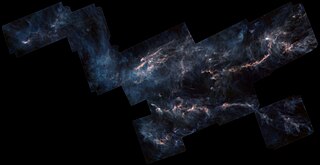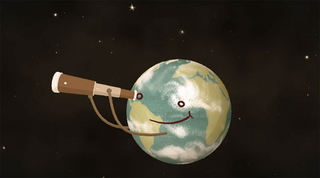
A rogueplanet, also termed a free-floating planet (FFP) or an isolated planetary-mass object (iPMO), is an interstellar object of planetary mass which is not gravitationally bound to any star or brown dwarf.
HD 83944 is a star system in the constellation Carina. This has the Bayer designation m Carinae, while HD 83944 is the identifier from the Henry Draper catalogue. It is a suspected variable with an apparent visual magnitude that fluctuates around 4.51 with an amplitude of 0.5. The system is located at a distance of approximately 226 light years from the Sun based on parallax, and it has an absolute magnitude of 0.31. It is a member of the Carina association of co-moving stars.
HD 98800, also catalogued as TV Crateris, is a quadruple star system in the constellation of Crater. Parallax measurements made by the Hipparcos spacecraft put it at a distance of about 150 light-years away. The system is located within the TW Hydrae association (TWA), and has received the designation TWA 4.

In astronomy, stellar kinematics is the observational study or measurement of the kinematics or motions of stars through space.

The Taurus molecular cloud (TMC-1) is an interstellar molecular cloud in the constellations Taurus and Auriga. This cloud hosts a stellar nursery containing hundreds of newly formed stars. The Taurus molecular cloud is only 140 pc away from Earth, making it possibly the nearest large star formation region. It has been important in star formation studies at all wavelengths.

A planetary-mass object (PMO), planemo, or planetary body is, by geophysical definition of celestial objects, any celestial object massive enough to achieve hydrostatic equilibrium, but not enough to sustain core fusion like a star.

SIMP J013656.5+093347 is a brown dwarf or planetary mass object at 19.9 light-years from Earth in the constellation Pisces. It belongs to the spectral class T2.5 and its position shifts due to its proper motion annually by about 1.24 arcsec in the right ascension.
2MASS J21392676+0220226 is a brown dwarf located 34 light-years from Earth in the constellation Aquarius. Its surface is thought to be host to a massive storm, resulting in large variability of its color. It is a member of the Carina-Near moving group. This brown dwarf was discovered in the Two Micron All-Sky Survey (2MASS).
2MASS J15031961+2525196 is a nearby brown dwarf of spectral type T5.5, located in the constellation of Boötes at approximately 20.7 light-years from Earth.
2MASS J03552337+1133437 is a nearby brown dwarf of spectral type L5γ, located in constellation Taurus at approximately 29.8 light-years from Earth.

WISE 0855−0714 is a sub-brown dwarf 2.28±0.01 parsecs from Earth, therefore the fourth-closest star or (sub-) brown dwarf system to the Sun, the discovery of which was announced in April 2014 by Kevin Luhman using data from the Wide-field Infrared Survey Explorer (WISE). As of 2014, WISE 0855−0714 has the third-highest proper motion after Barnard's Star and Kapteyn's Star and the fourth-largest parallax of any known star or brown dwarf. It is also the coldest object of its type found in interstellar space, having a temperature in the range 225 to 260 K.

Backyard Worlds: Planet 9 is a NASA-funded citizen science project which is part of the Zooniverse web portal. It aims to discover new brown dwarfs, faint objects that are less massive than stars, some of which might be among the nearest neighbors of the Solar System, and might conceivably detect the hypothesized Planet Nine. The project's principal investigator is Marc Kuchner, an astrophysicist at NASA's Goddard Space Flight Center.
A Peter Pan disk is a circumstellar disk around a star or brown dwarf that appears to have retained enough gas to form a gas giant planet for much longer than the typically assumed gas dispersal timescale of approximately 5 million years. Several examples of such disks have been observed to orbit stars with spectral types of M or later. The presence of gas around these disks has generally been inferred from the total amount of radiation emitted from the disk at infrared wavelengths, and/or spectroscopic signatures of hydrogen accreting onto the star. To fit one specific definition of a Peter Pan disk, the source needs to have an infrared "color" of , an age of >20 Myr and spectroscopic evidence of accretion.

The Tucana-Horologium association (Tuc-Hor), or Tucana Horologium moving group, is a stellar association with an age of 45 ± 4 Myr and it is one of the largest stellar associations within 100 parsecs. The association has a similar size to the Beta Pictoris moving group (BPMG) and contains, like BPMG, more than 12 stars with spectral type B, A and F. The association is named after two southern constellations, the constellation Tucana and the constellation Horologium.
TOI-1227 b is one of the youngest transiting exoplanets discovered, alongside K2-33b and HIP 67522 b. The exoplanet TOI-1227 b is about 11±2 Myrs old and currently 9.5 R🜨 large. It will become a 3-5 R🜨 planet in about 1 billion years, because the planet is still contracting. TOI-1227 b orbits a very low-mass star every 27.36 days.









